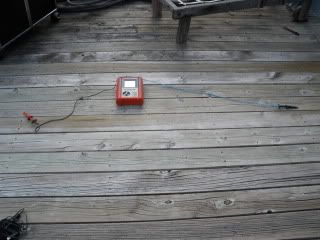The resistivities I gave were for moisture content below the fiber saturation point (fsp). Green wood not only has water in the wood fibers (bound water) but also in the lumens (the open cavities holding free water). After green wood loses the free water, from then on, we are talking about moisture content up to the fsp, which will be less than the initial green wood which also had free water. I supposed you could really soak the wood and get some water back into the lumens. While some wood treatments reside mostly in the wood fibers, some treatments reside primarily in the lumens..
The resistivity values I gave were not for green wood but for wood with moisture in the fibers. The moisture content is the weight of the water as a percentage of the oven dried wood weight. Green hardwoods are about 60% and softwoods can go over 200% moisture.
The wood we normally use has been dried and has lost the free water. The relative humidity will cause water to diffuse in and out of the wood fibers. Some approximate equilibrium moisture content (EMC) equilibrium points for different humidity levels can be found in table 3-4 of the
USDA Wood Handbook A formula that approximates the tables can be found in formula 3-3.
You will find that the fibers are saturated at about 30% moisture and moisture moves by diffusion to reach equilibrium. The idea being that at equilibrium, the moisture is pretty much constant throughout the wood fibers. If the humidity then changes, it takes time for the wood to reach a new equilibrium point. This time in seconds for 63% of this change to occur can be approximated by t = L? / D where L is the length in the diffusion direction and D equals 1x10-6 cm?/s for transverse and radial and D equals 1x10-5 cm?/s for lengthwise. As the D values show, moisture moves 10X as fast length-wise as it does cross-wise.
Anyway, for resistance measurements, you are measuring the resistance along the grain of the wood. Here are some calibration values for a pin-type wood moisture meter using 10mm penetration and 30mm pin separation:
moisture %:megaohms
8:4800
10:630
12:120
14:33
16:11
18:4.5
20:2.1
I have a pin-less moisture meter that reads using an electromagnetic wave sent through the wood and is supposed to read the average moisture throughout the material. To get the average moisture content using pins, you need to penetrate to a 20-25% depth. Meter readings should also be adjusted for temperature.
Ideally, you would let the wood reach equilibrium and then take a measurement. When spraying on water, you are wetting the surface of wood and throwing the equilibrium off. You have saturated the wood fibers on top, getting close to 100% moisture on the surface. Not only that, but you are reading the resistance of free water running along, and maybe just under, the surface.
So when you hose down the wood, you are mainly reading three parallel resistances:
The wood on the surface which is probably at the fsp.
The wood just under the surface, which is somewhere between the prior equilibrium point and the wet surface wood.
The free water running along the surface and saturating the cavities just below the surface and running by capillary action.
The result being that you can find resistances less than those normally used to measure the amount of water in wood fibers. Wet the wood enough and you will essentially be measuring the resistance of the liquid used to wet the wood.


